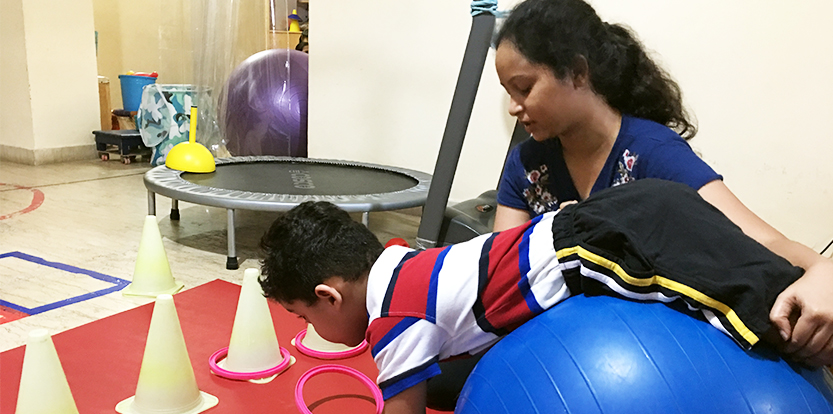
In India, where understanding and acceptance of autism are on the rise, Sensory Integration Therapy (SIT) has become an increasingly important treatment for children with autism spectrum disorders (ASD). This therapeutic approach is specifically designed to assist children in managing their sensory sensitivities—challenges that can significantly impact their day-to-day functioning and overall quality of life. SIT aims to help these children better process and respond to the sensory stimuli they encounter in their environments, such as touch, sound, and visual inputs, which they may find overwhelming or distracting.
By improving their ability to handle these sensory inputs, SIT can enhance their cognitive development, emotional well-being, and social interactions. This approach not only aids in their personal growth but also supports their ability to participate more fully in educational settings and social activities, fostering a sense of inclusion and improving their life experiences. Here, we delve deeper into how Sensory Integration Therapy can contribute to the development and well-being of children with autism, offering them a more balanced and accessible world.
Understanding Sensory Integration Therapy
This Therapy is designed to help children with autism improve how they process sensory information. Many children with autism experience hypersensitivities or hyposensitivities to sensory inputs, such as touch, sound, and light. SIT aims to help these children adjust to sensory stimuli more effectively, thereby enhancing their ability to participate in everyday activities and social interactions.

Benefits of Sensory Integration Therapy for Autism
Enhanced Sensory Processing: Children with autism often struggle with processing sensory information. This Therapy helps these children by gradually exposing them to sensory stimuli in a structured environment, which can improve their sensory processing abilities over time. This improvement can lead to better focus, decreased anxiety, and enhanced learning capabilities.
Improved Social Interactions
SIT is designed to help children with autism manage how they perceive and process sensory information from their environment. For many children with autism, social settings can be overwhelming due to sensory overload—too much noise, too many people, or intense visual stimuli can all be difficult to handle. SIT techniques aim to reduce this overload, making these environments feel more comfortable and less threatening. As children become more comfortable, they are able to improve their communication skills and have more meaningful interactions. This is crucial for their social development as it helps them build relationships and better integrate into social groups, whether at school or within the family.

Increased Participation in Daily Activities
Explanation: Sensory challenges often prevent children with autism from fully participating in everyday activities like schooling, playing outdoors, or engaging in family gatherings. These activities, while normal for other children, can seem insurmountable for children with sensory processing difficulties due to the unpredictable nature of sensory inputs they encounter. SIT provides these children with tools and strategies to manage their sensory experiences, such as sensory diets (customized schedules of sensory activities), the use of sensory aids (like noise-canceling headphones), and controlled exposure to various stimuli. This not only helps them participate more in these activities but also promotes a sense of independence and enhances self-esteem, as they are able to do more on their own without feeling overwhelmed.

Reduction in Problematic Behaviors
Explanation: Behavioral issues in children with autism often stem from their struggles with sensory processing. For example, an unexpected loud noise might trigger a tantrum, or an uncomfortable clothing texture might lead to withdrawal. These behaviors are coping mechanisms for uncomfortable sensory experiences. Sensory Integration Therapy helps by teaching these children more appropriate ways to respond to their sensory environments. Techniques might include sensory modulation strategies like deep pressure activities or structured sensory play, which help the child manage their sensory input and reduce their need to resort to disruptive behaviors. This training gradually leads to fewer episodes of tantrums, withdrawal, aggression, and other problematic behaviors.
Implementing Sensory Integration Therapy in India
Explanation: In India, the process of accessing SIT involves several steps. Families must first consult with healthcare providers who specialize in autism and understand sensory processing issues, typically occupational therapists. These specialists can perform detailed assessments of a child’s sensory needs to identify specific sensitivities and challenges. Based on this assessment, a personalized therapy plan is developed, tailored to the child’s unique requirements. To find appropriate services, families should look for clinics and therapy centers that offer specialized services for autism, particularly those that focus on sensory integration. These centers often have trained occupational therapists who use a variety of tools and techniques designed specifically to aid children with autism in managing their sensory processing issues.

Conclusion
SIT offers a promising approach to helping children with autism in India manage their sensory sensitivities. By focusing on individual needs and providing tailored therapeutic interventions, SIT can significantly improve the quality of life for these children and their families. If you think SIT might benefit your child, consider consulting with a healthcare provider who specializes in autism and sensory integration issues to learn more about your options.
Treat your child with the best Sensory Integration Therapy in Noida at Nurturers, where specialized care meets compassion and expertise.



